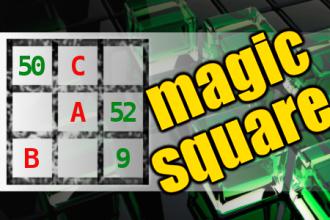MAGIC SQUARE: Calculate A+B-C
The aim is to place the some numbers from the list (4, 6, 7, 9, 11, 12, 27, 50, 52, 53) into the empty squares and squares marked with A, B an C. Sum of each row and column should be equal. All the numbers of the magic square must be different. Find values for A, B, and C. Solution is A+B-C.Correct answers: 9
The first user who solved this task is Nasrin 24 T.
#brainteasers #math #magicsquare

A woman awakes during the nigh...
A woman awakes during the night to find that her husband is not in their bed. She puts on her robe and goes downstairs to look for him. She finds him sitting at the kitchen table with a cup of coffee in front of him. He appears deep in thought, just staring at the wall. She watches as he wipes a tear from his eye and takes a sip of coffee. "What's the matter, dear?" she whispers as she steps into the room. "Why are you down here at this time of night?" The husband looks up, "Do you remember 20 years ago when we were dating, and you were only 17?" he asks solemnly. The wife is touched, thinking her husband is so caring and sensitive. "Yes, I do," she replies. The husband pauses. The words are not coming easily. "Do you remember when your father caught us in the backseat of my car?" "Yes, I remember," says the wife, lowering herself into a chair beside him. The husband continues, "Do you remember when he shoved a shotgun in my face and said, "Either you marry my daughter, or I will send you to jail for 20 years!" "I remember that too," she replies softly. He wipes another tear from his cheek and says, "I would have gotten out today!"

